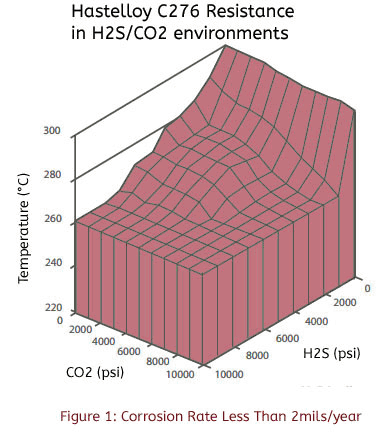 Oilfields are subjected to a diversity of corrosive elements including carbonic acids, sour gas (H2S), and fracking/stimulant acids such as hydrochloric and hydrofluoric acid. Naphthenic acids and simple organic acids are also found in crude oil extraction. In conjunction to acids, these environments contain sand and other abrasive elements which cause erosion, and hence accelerating corrosion via erosion-corrosion. Water flooding, elevated temperatures and high pressures also contribute to this corrosive environment. Stainless steels such as 304 and 316 often cannot handle these highly corrosive conditions and specialty nickel alloys are needed. This brief blog will discuss the benefits of specialty alloy fasteners that are crucial to preventing oil field corrosion and minimize failures.
Oilfields are subjected to a diversity of corrosive elements including carbonic acids, sour gas (H2S), and fracking/stimulant acids such as hydrochloric and hydrofluoric acid. Naphthenic acids and simple organic acids are also found in crude oil extraction. In conjunction to acids, these environments contain sand and other abrasive elements which cause erosion, and hence accelerating corrosion via erosion-corrosion. Water flooding, elevated temperatures and high pressures also contribute to this corrosive environment. Stainless steels such as 304 and 316 often cannot handle these highly corrosive conditions and specialty nickel alloys are needed. This brief blog will discuss the benefits of specialty alloy fasteners that are crucial to preventing oil field corrosion and minimize failures.
The Hastelloy family of nickel alloys is commonly used to prevent oil field corrosion. Hastelloy C276 bolting is used sour gas oil field situations and can be used to 8,000 psi H2S and 400°F. The following chart demonstrates the corrosion resistance of Hastelloy C276 fasteners in H2S/CO2 environments in the absence of elemental sulphur. Corrosion rates of ≤0.05 mm/yr (2mpy) and no SSC or SCC.
 Sulphur has been found to cause severe pitting and catastrophic cracking even among many nickel alloys. This is another instance where corrosion resistant Hastelloy C276 fasteners perform very well through their ability to prevent sulfur-induced stress cracking. This is particularly important for fasteners that perform critical applications as a relatively small amount of corrosion can cause fasteners to fail. C276 also provides excellent protection to carbonic acid, organic acid and water-related corrosion. It is also immune to CO2 related corrosion which can be common in wells.
Sulphur has been found to cause severe pitting and catastrophic cracking even among many nickel alloys. This is another instance where corrosion resistant Hastelloy C276 fasteners perform very well through their ability to prevent sulfur-induced stress cracking. This is particularly important for fasteners that perform critical applications as a relatively small amount of corrosion can cause fasteners to fail. C276 also provides excellent protection to carbonic acid, organic acid and water-related corrosion. It is also immune to CO2 related corrosion which can be common in wells.
Hydrochloric acid found in fracking and well stimulants is also another corrosive element where Hastelloy can be useful. Hastelloy C276 bolts are resistant to all concentrations of hydrochloric acid at room temperature, and can be employed successfully up to about 120°F. For more extreme temperatures and concentrations of HCl, materials like Hastelloy C2000 and tantalum should be used.
Incoloy 825 and 925 are common choices for sour gas well corrosion protection even at elevated temperatures. Incoloy 825 provides excellent resistance to H2S with Incoloy 925 bolts being ideal when a combination of high strength and corrosion resistance is needed. The high strength (167.3 ksi tensile strength) of Incoloy 925 bolts are ideal for high pressure processes often encountered down hole. Incoloy 925 bolts also help protect from chloride related corrosion that can occur as well.
Hydrofluoric acid used in fracking is one of the corrosive elements – even eating through solid tantalum which is inert to most all acids. To combat Hydrofluoric acid, we recommend using Monel 400 or Hastelloy C2000. These are among the very few materials that can handle this environment.

Your blog is really good to read. I love this content.